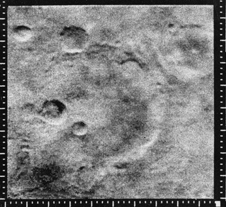July 30, 2010 Vol. 3, Issue 7
Mariner 4 flew by Mars and beamed down the first images of another planet on July 14-15, 1965.

Image of the Mariner Crater taken from 12,600km above the Martian surface. Credit: NASA
“A heavy, perhaps fatal, blow was delivered today to the possibility that there is or once was life on Mars,” read a front-page, July 29, 1965 New York Times story about the images returned from the Mariner 4 spacecraft, which had flown by Mars two weeks earlier.*
1964 was an optimistic time for exobiologists looking for life outside of Earth. In 1960, NASA formed the Office of Life Sciences, which sparked the beginnings of the Mariner Program. In total, 10 Mariner spacecraft would visit Venus, Mars, and Mercury.
Mariner 3 was the first Mars flyby attempt. It launched on November 5, 1964, but the nose faring did not detach properly, and the spacecraft drifted off into solar orbit. Seventeen days later, Mariner 4 launched on November 28, 1964 and started its seven-and-a-half month, 525-million-kilometer journey to Mars. The Mariner 4 spacecraft was an octagonal, 260-kilogram structure with four solar panels. The craft was just over nine feet tall, with a mounted TV camera and several instruments including a magnetometer, dust detector, cosmic ray telescope, trapped radiation detector, solar plasma probe, and an ionization chamber (Geiger counter).
On July 14 and 15, Mariner 4 flew by the planet and returned the first images of the Martian surface. The Jet Propulsion Laboratory received 21 full images and one partial image, representing 1% of the planet, taken from approximately 13,000 km above the surface. The $83.2 million mission returned 5.2 megabits of data and measured the planet’s temperatures, atmospheric pressures, and magnetic field (none detected) in addition to the imaging.
The images revealed little in the way of life on Mars. Instead of finding intriguing canals or mountain-like structures, Mariner 4 relayed pictures of craters, suggesting Mars was more Moon-like than Earth-like. While NASA did caution that the Mariner 4 mission would not solve the mystery of the presence of life on Mars, the results were something of a blow at the time.
“It may be, it just may be, that life as we know it with its humanity is more unique than many have thought,” President Lyndon B. Johnson said after the mission completed. Three more Mariner missions would venture off to Mars, ending with Mariner 9 in 1971.
Since Mariner 4, missions to Mars have found vast amounts of ice underneath the surface of the planet. Some researchers believe to have found evidence of previous life on Mars, but their conclusions have yet to win over the larger scientific community.
Read more about the Mariner Program.
*Walter Sullivan, Mariner 4s Final Photos Depict a Moonlike Mars, New York Times, 29 July 1965.





